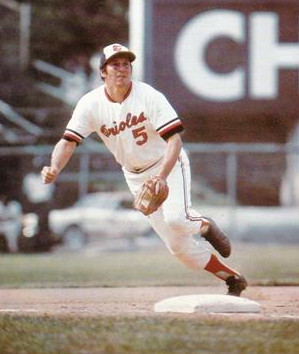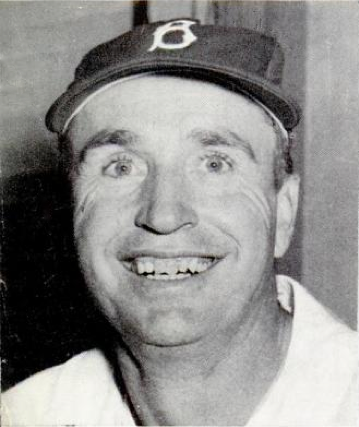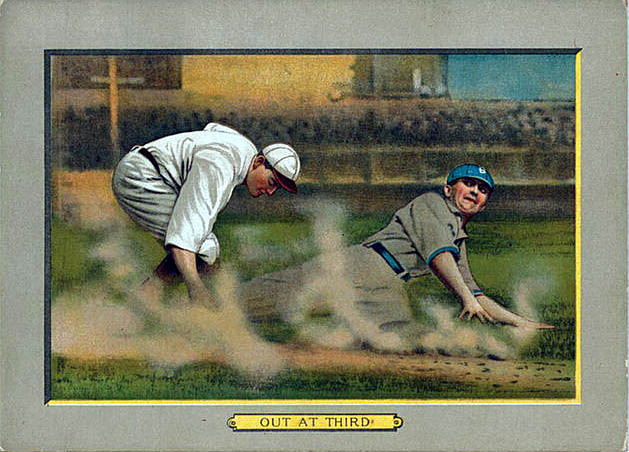|
Jim Command
James Dalton Command (October 15, 1928 – August 10, 2014) was an American professional baseball player and scout. He had two separate trials with the 1954–55 Philadelphia Phillies of Major League Baseball (MLB), starting four games as a third baseman in July 1954, while also serving as a pinch hitter and pinch runner, playing in a total of 14 big league games. However, Command was a versatile performer during a 14-season (1947–1959; 1962) minor league career – playing all the infield positions, the outfield, and, late in his career, converting to catcher. Playing career Command batted left-handed, threw right-handed, stood tall and weighed ; he was a lifelong resident of Grand Rapids, Michigan and attended Creston High School (Michigan). He was in his eighth year in the Phillies' farm system when he received his first MLB opportunity in the midst of the 1954 season. After going hitless in his first four at bats as a pinch hitter and substitute third baseman, he st ... [...More Info...] [...Related Items...] OR: [Wikipedia] [Google] [Baidu] |
Third Baseman
A third baseman, abbreviated 3B, is the player in baseball or softball whose responsibility is to defend the area nearest to third base — the third of four bases a baserunner must touch in succession to score a run. In the scoring system used to record defensive plays, the third baseman is assigned the number 5. Third base is known as the "hot corner", because the third baseman is often the infielder who stands closest to the batter—roughly 90–120 feet away, but even closer if a bunt is expected. Most right-handed hitters tend to hit the ball hard in this direction. A third baseman must possess good hand-eye coordination and quick reactions to catch batted balls whose speed can exceed . The third base position requires a strong and accurate arm, as the third baseman often makes long throws to first base or quick ones to second base to start a double play. As with middle infielders, right-handed throwing players are standard at the position because they do not need to ... [...More Info...] [...Related Items...] OR: [Wikipedia] [Google] [Baidu] |
Creston High School (Michigan)
Creston High School opened in 1923 as Creston Junior High School, with its first class graduating in 1927. This school was one of the five high schools in Grand Rapids, Michigan. At its peak, it housed around one thousand students and over fifty teachers making the teacher to student ratio about 1:20. The school mascot was the polar bear. The colors were blue and gold. Closure In 2012 the district administration proposed closure of Creston, on the basis of an enrollment decrease, as part of a plan to shutter ten campuses. Monica Scott of MLive wrote that "biggest push back has come from closing Creston High School." As part of a realignment among Grand Rapids Public Schools high schools, Creston was consolidated with Grand Rapids Central High School. The consolidated high school kept the Grand Rapids Central High School name and location. Students who lived too far from Grand Rapids Central's location have been allowed to attend the high school nearest their neighborhood, in ... [...More Info...] [...Related Items...] OR: [Wikipedia] [Google] [Baidu] |
Walter Alston
Walter Emmons Alston (December 1, 1911 – October 1, 1984), nicknamed "Smokey", was an American baseball player and manager in Major League Baseball He is best known for managing the Brooklyn/Los Angeles Dodgers from 1954 through 1976, and signed 23 one-year contracts with the He had a calm, reticent demeanor, for which he was sometimes also known as "The Quiet Man." Alston grew up in rural Ohio and lettered in baseball and basketball at Miami University in Oxford. Though his MLB playing career consisted of only one game, two innings played, and one at-bat with the St. Louis Cardinals in 1936, Alston spent 19 years in minor league baseball as a player (1935–1939 and 1943), player-manager (1940–1942, 1944–1947) and non-playing manager (1948–1953). His service included a stint as skipper of the 1946 Nashua Dodgers, the first U.S.-based integrated professional team in modern baseball. He was promoted to manage the Brooklyn Dodgers in 1954 after six successful seasons ... [...More Info...] [...Related Items...] OR: [Wikipedia] [Google] [Baidu] |
Manager (baseball)
In baseball, the field manager (commonly referred to as the manager) is the equivalent of a head coach who is responsible for overseeing and making final decisions on all aspects of on-field team strategy, lineup selection, training and instruction. Managers are typically assisted by a staff of assistant coaches whose responsibilities are specialized. Field managers are typically not involved in off-field personnel decisions or long-term club planning, responsibilities that are instead held by a team's general manager. Duties The manager chooses the batting order and starting pitcher before each game, and makes substitutions throughout the game – among the most significant being those decisions regarding when to bring in a relief pitcher. How much control a manager takes in a game's strategy varies from manager to manager and from game to game. Some managers control pitch selection, defensive positioning, decisions to bunt, steal, pitch out, etc., while others desig ... [...More Info...] [...Related Items...] OR: [Wikipedia] [Google] [Baidu] |
Bases Loaded
B backdoor breaking ball :A breaking pitch, usually a slider, curveball, or cut fastball that, due to its lateral motion, passes through a small part of the strike zone on the outside edge of the plate after seeming as if it would miss the plate entirely. It may not cross the front of the plate but only the back and thus have come in through the "back door". A slider is the most common version, because a slider has more lateral motion than other breaking pitches (it curves down and 'slides' across the zone). backstop :*The fence behind homeplate, designed to protect spectators from wild pitches or foul balls. :*Catcher, sometimes "backstopper". back-to-back :Consecutive. When two consecutive batters hit home runs, they are said to hit back-to-back homers. Or a pitcher may issue back-to-back walks, and so forth. bad-ball hitter :A batter who excels at hitting pitches that are outside the strike zone. Notable bad ball hitters include Yogi Berra and Vladimir Guerrero. bad ho ... [...More Info...] [...Related Items...] OR: [Wikipedia] [Google] [Baidu] |
Out (baseball)
In baseball, an out occurs when the umpire rules a batter or baserunner out. When a batter or runner is out, they lose their ability to score a run and must return to the dugout until their next turn at bat. When three outs are recorded in a half-inning, the batting team's turn expires. To signal an out, an umpire generally makes a fist with one hand, and then flexes that arm either upward, particularly on pop flies, or forward, particularly on routine plays at first base. Home plate umpires often use a "punch-out" motion to signal a called strikeout. Ways of making outs * The most common ways batters or runners are put out are when: ** The batter strikes out (they make three batting mistakes, known as ''strikes'', without hitting the ball into fair territory); ** The batter flies out (they hit the ball and it is caught before landing); ** a baserunner is tagged out (they are touched by the ball, held in an opponent's hand, while not on a base); ** a baserunner is forced ... [...More Info...] [...Related Items...] OR: [Wikipedia] [Google] [Baidu] |
Inning (baseball)
In baseball, softball, and similar games, an inning is the basic unit of play, consisting of two halves or frames, the "top" (first half) and the "bottom" (second half). In each half, one team bats until three outs are made, with the other team playing defense. A full baseball game is typically scheduled for nine innings, while softball games consist of seven innings; although this may be shortened due to weather or extended if the score is tied at the end of the scheduled innings. The use of the term ''inning'' in baseball and softball contrasts with cricket and rounders, in which the term is ''innings'' in both singular and plural. Gameplay Each half-inning formally starts when the umpire calls "Play" or "Play ball". A full inning consists of six outs, three for each team; and, in Major League Baseball and most other adult leagues, a regulation game consists of nine innings. The visiting team bats in the first half-inning, the ''top'' of the inning, derived from the position ... [...More Info...] [...Related Items...] OR: [Wikipedia] [Google] [Baidu] |
Plate Appearances
In baseball statistics, a player is credited with a plate appearance (denoted by PA) each time he completes a turn batting. Under Rule 5.04(c) of the Official Baseball Rules, a player completes a turn batting when he is put out or becomes a runner. This happens when he strikes out or is declared out before reaching first base; or when he reaches first base safely or is awarded first base (by a base on balls, hit by pitch, catcher's interference, or obstruction); or when he hits a fair ball which causes a preceding runner to be put out for the third out before he himself is put out or reaches first base safely (''see also'' left on base, fielder's choice, force play). A very similar statistic, at bats, counts a subset of plate appearances that end under certain circumstances. Use as batting record qualifier While at bats are used to calculate batting averages, slugging percentages, plate appearances have no such statistical value. However, at season's end, a player must have a ... [...More Info...] [...Related Items...] OR: [Wikipedia] [Google] [Baidu] |
Carl Erskine
Carl Daniel Erskine (born December 13, 1926) is a former right-handed starting pitcher in Major League Baseball who played his entire career for the Brooklyn / Los Angeles Dodgers from 1948 through 1959. He was a pitching mainstay on Dodger teams which won five National League pennants, peaking with a season in which he won 20 games and set a World Series record with 14 strikeouts in a single game. Erskine pitched two of the NL's seven no-hitters during the 1950s. Following his baseball career, he was active as a business executive and an author. Career Erskine broke into the majors a year before Don Newcombe, and from 1948–50 was used primarily as a reliever, going 21-10. In 1951, he mixed 19 starts with 27 relief appearances, and went 16-12. Erskine was 14-6 in 1952 with a career-best 2.70 earned run average, then had his 20-win season in 1953, leading the league with a .769 winning percentage along with 187 strikeouts and 16 complete games, all career highs. This was fol ... [...More Info...] [...Related Items...] OR: [Wikipedia] [Google] [Baidu] |
Base On Balls
A base on balls (BB), also known as a walk, occurs in baseball when a batter receives four pitches that the umpire calls '' balls'', and is in turn awarded first base without the possibility of being called out. The base on balls is defined in Section 2.00 of baseball's Official Rules, and further detail is given in 6.08(a). It is considered a faux pas for a professional player to literally walk to first base; the batter-runner and any advancing runners normally jog on such a play. The term "base on balls" distinguishes a walk from the other manners in which a batter can be awarded first base without liability to be put out (e.g., hit by pitch (HBP), catcher's interference). Though a base on balls, catcher's interference, or a batter hit by a pitched ball all result in the batter (and possibly runners on base) being awarded a base, the term "walk" usually refers only to a base on balls, and not the other methods of reaching base without the bat touching the ball. An importan ... [...More Info...] [...Related Items...] OR: [Wikipedia] [Google] [Baidu] |
Ebbets Field
Ebbets Field was a Major League Baseball stadium in the Flatbush section of Brooklyn, New York. It is mainly known for having been the home of the Brooklyn Dodgers baseball team of the National League (1913–1957). It was also home to five professional football teams, including three NFL teams (1921–1948). Ebbets Field was demolished in 1960 and replaced by the Ebbets Field Apartments, later renamed the Jackie Robinson Apartments. History Construction Ebbets Field was bounded by Bedford Avenue to the east, Sullivan Place to the South, Cedar Street (renamed McKeever Place in 1932) to the west, and Montgomery Street to the north. After locating the prospective new site to build a permanent stadium to replace the old wooden Washington Park, Dodgers' owner Charles Ebbets acquired the property over several years, starting in 1908, by buying lots until he owned the entire block. The land included the site of a garbage dump called Pigtown, so named because of the pigs that ... [...More Info...] [...Related Items...] OR: [Wikipedia] [Google] [Baidu] |
Brooklyn Dodgers
The Brooklyn Dodgers were a Major League Baseball team founded in 1884 as a member of the American Association (19th century), American Association before joining the National League in 1890. They remained in Brooklyn until 1957, after which the club moved to Los Angeles, California, where it continues History of the Los Angeles Dodgers, its history as the Los Angeles Dodgers. The team moved west at the same time as its longtime rival, the New York Giants (baseball), New York Giants, relocated to San Francisco in northern California as the San Francisco Giants. The team's name derived from the reputed skill of Brooklyn residents at evading List of streetcar lines in Brooklyn, the city's trolley streetcars. The name is a shortened form of their old name, the Brooklyn ''Trolley'' Dodgers. The Dodgers played in two stadiums in South Brooklyn, each named Washington Park (baseball), Washington Park, and at Eastern Park in the neighborhood of Brownsville, Brooklyn, Brownsville before m ... [...More Info...] [...Related Items...] OR: [Wikipedia] [Google] [Baidu] |



.jpg)


